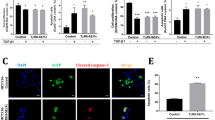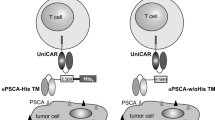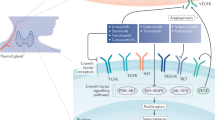Abstract
Significant advantage of targeted antitumoral treatment consists in the possibility to restrict maximum therapeutic efficacy to the malignant cell population by reducing toxicity in healthy tissues. Using different clinical models for aggressive medullary thyroid carcinoma (MTC), we have recently identified peptide ligands that bind highly selective to tumor cells. By linking the most convincing SRESPHP peptide to an adenoviral (Ad) vector expressing the MTC-related oncogene inhibitor RETΔTK, gene transfer was specifically directed to neoplastic tissue after systemic virus administration. We show that peptide-mediated delivery of RETΔTK significantly enhanced apoptosis, resulting in a strong inhibition of orthotopic and xenograft tumor growth. Conversely, tumors treated with controls expanded their initial size without notable cell death. According to the therapeutic effect, strong virus accumulation was found exclusively in thyroid carcinomas. Strikingly, application of native tropism depleted viral vector linked to tumor-selective peptide was accompanied by a substantial reduction of Ad binding to the liver. Of note, single systemic injection of a low dose (10e8 pfu/mouse) of MTC-specific Ad.RETΔTK induced regression of multiple tumors at different sites in all treated animals. In sum, our results open up the possibility for an efficient cancer cell-specific therapy of primary MTC, their migrating populations and potentially metastases.
This is a preview of subscription content, access via your institution
Access options
Subscribe to this journal
Receive 12 print issues and online access
$259.00 per year
only $21.58 per issue
Buy this article
- Purchase on Springer Link
- Instant access to full article PDF
Prices may be subject to local taxes which are calculated during checkout




Similar content being viewed by others
References
Sherman SI . Thyroid carcinoma. Lancet 2003; 361: 501–511.
Machens A, Lorenz K, Dralle H . Constitutive RET tyrosine kinase activation in hereditary medullary thyroid cancer: clinical opportunities. J Intern Med 2009; 266: 114–125.
Massoll N, Mazzaferri EL . Diagnosis and management of medullary thyroid carcinoma. Clin Lab Med 2004; 24: 49–83.
Manie S, Santoro M, Fusco A, Billaud M . The RET receptor: function in development and dysfunction in congenital malformation. Trends Genet 2001; 17: 580–589.
Hansford JR, Mulligan LM . Multiple endocrine neoplasia type 2 and RET: from neoplasia to neurogenesis. J Med Genet 2000; 37: 817–827.
Yip L, Cote GJ, Shapiro SE, Ayers GD, Herzog CE, Sellin RV et al. Multiple endocrine neoplasia type 2: evaluation of the genotype-phenotype relationship. Arch Surg 2003; 138: 409–416; discussion 416.
Engelmann D, Koczan D, Ricken P, Rimpler U, Pahnke J, Li Z et al. Transcriptome analysis in mouse tumors induced by Ret-MEN2/FMTC mutations reveals subtype-specific role in survival and interference with immune surveillance. Endocr Relat Cancer 2009; 16: 211–224.
Miše N, Drosten M, Racek T, Tannapfel A, Pützer BM . Evaluation of potential mechanisms underlying genotype-phenotype correlations in multiple endocrine neoplasia type 2. Oncogene 2006; 25: 6637–6647.
Drosten M, Putzer BM . Mechanisms of disease: cancer targeting and the impact of oncogenic RET for medullary thyroid carcinoma therapy. Nat Clin Pract Oncol 2006; 3: 564–574.
Carlomagno F, Vitagliano D, Guida T, Napolitano M, Vecchio G, Fusco A et al. The kinase inhibitor PP1 blocks tumorigenesis induced by RET oncogenes. Cancer Res 2002; 62: 1077–1082.
Cuccuru G, Lanzi C, Cassinelli G, Pratesi G, Tortoreto M, Petrangolini G et al. Cellular effects and antitumor activity of RET inhibitor RPI-1 on MEN2A-associated medullary thyroid carcinoma. J Natl Cancer Inst 2004; 96: 1006–1014.
Lanzi C, Cassinelli G, Pensa T, Cassinis M, Gambetta RA, Borrello MG et al. Inhibition of transforming activity of the ret/ptc1 oncoprotein by a 2-indolinone derivative. Int J Cancer 2000; 85: 384–390.
Cerchia L, Ducongé F, Pestourie C, Boulay J, Aissouni Y, Gombert K et al. Neutralizing aptamers from whole-cell SELEX inhibit the RET receptor tyrosine kinase. PLoS Biol 2005; 3: e123.
Cerchia L, Libri D, Carlomagno MS, de Franciscis V . The soluble ectodomain of RetC634Y inhibits both the wild-type and the constitutively active Ret. Biochem J 2003; 372: 897–903.
Drosten M, Frilling A, Stiewe T, Putzer BM . A new therapeutic approach in medullary thyroid cancer treatment: inhibition of oncogenic RET signaling by adenoviral vector-mediated expression of a dominant-negative RET mutant. Surgery 2002; 132: 991–997; discussion 997.
Drosten M, Putzer BM . Gene therapeutic approaches for medullary thyroid carcinoma treatment. J Mol Med 2003; 81: 411–419.
Böckmann M, Drosten M, Putzer BM . Discovery of targeting peptides for selective therapy of medullary thyroid carcinoma. J Gene Med 2005; 7: 179–188.
Böckmann M, Hilken G, Schmidt A, Cranston AN, Tannapfel A, Drosten M et al. Novel SRESPHP peptide mediates specific binding to primary medullary thyroid carcinoma after systemic injection. Hum Gene Ther 2005; 16: 1267–1275.
Alemany R, Curiel DT . CAR-binding ablation does not change biodistribution and toxicity of adenoviral vectors. Gene Therapy 2001; 8: 1347–1353.
Drosten M, Hilken G, Böckmann M, Rödicker F, Misê N, Cranston AN et al. Role of MEN2A-derived RET in maintenance and proliferation of medullary thyroid carcinoma. J Natl Cancer Inst 2004; 96: 1231–1239.
Cranston AN, Ponder BA . Modulation of medullary thyroid carcinoma penetrance suggests the presence of modifier genes in a RET transgenic mouse model. Cancer Res 2003; 63: 4777–4780.
Reynolds L, Jones K, Winton DJ, Cranston A, Houghton C, Howard L et al. C-cell and thyroid epithelial tumours and altered follicular development in transgenic mice expressing the long isoform of MEN 2A RET. Oncogene 2001; 20: 3986–3994.
Bangari DS, Mittal SK . Current strategies and future directions for eluding adenoviral vector immunity. Curr Gene Ther 2006; 6: 215–226.
Vitale G, Caraglia M, Ciccarelli A, Lupoli G, Abbruzzese A, Tagliaferri P et al. Current approaches and perspectives in the therapy of medullary thyroid carcinoma. Cancer 2001; 91: 1797–1808.
Boulay A, Breuleux M, Stephan C, Fux C, Brisken C, Fiche M et al. The ret receptor tyrosine kinase pathway functionally interacts with the era pathway in breast cancer. Cancer Res 2008; 68: 3743–3751.
Plaza-Menacho I, Morandi A, Robertson D, Pancholi S, Drury S, Dowsett M et al. Targeting the receptor tyrosine kinase RET sensitizes breast cancer cells to tamoxifen treatment and reveals a role for RET in endocrine resistance. Oncogene 2010; 29: 4648–4657.
Boikos SA, Stratakis CA . Molecular mechanisms of medullary thyroid carcinoma: current approaches in diagnosis and treatment. Histol Histopathol 2008; 23: 109–116.
Ramaswamy S, Ross KN, Lander ES, Golub TR . A molecular signature of metastasis in primary solid tumors. Nat Genet 2003; 33: 49–54.
Yamada H, Hasegawa Y, Mitsudomi T, Nakashima T, Yatabe Y . Neuroendocrine tumor metastasis to the thyroid gland. Int J Clin Oncol 2007; 12: 63–67.
Acknowledgements
We thank Anja Stoll for excellent technical assistance, Kathrin Sievert-Küchenmeister for expert support in animal surgery and Thomas Brüning for immunohistochemistry. This work was supported by DFG Grants PU 188/5-1/5-2, PU 188/5-3 and the FORUN program (Grant 889017) of Rostock University Medical Faculty.
Author information
Authors and Affiliations
Corresponding author
Ethics declarations
Competing interests
The authors declare no conflict of interest.
Rights and permissions
About this article
Cite this article
Schmidt, A., Eipel, C., Fürst, K. et al. Evaluation of systemic targeting of RET oncogene-based MTC with tumor-selective peptide-tagged Ad vectors in clinical mouse models. Gene Ther 18, 418–423 (2011). https://doi.org/10.1038/gt.2010.165
Received:
Revised:
Accepted:
Published:
Issue Date:
DOI: https://doi.org/10.1038/gt.2010.165



